
Our team at BRS are always using different leadership and development tools within the team, bid, project and organisation coaching and facilitation services we provide to our clients. However, unless you are accredited in these tools or work in this space, it can be really confusing when trying to identify what tool would be most appropriate for yourself, your team or your organisation.
Within this blog, I’m going to give you a little insight into my experiences with the tools we use and recommend at BRS. It is probably also important for me to highlight that I’m not accredited in any of these tools, but I have used them throughout my career, so I have become quite familiar with them. At BRS we regularly undertake sessions in each of these tools, not just for our own self-awareness and development, but so we can work more cohesively as a team, understand each other’s preferences and strengths and be able to talk about the benefits of each tool with our clients.
Human Synergistics
The Human Synergistics assessments are probably our most commonly requested leadership and development tools used predominantly for senior managers and executives in both project teams and within organisations.
The Human Synergistics framework is based on the Circumplex and it brings together 12 styles of thinking and behaving across three clusters:
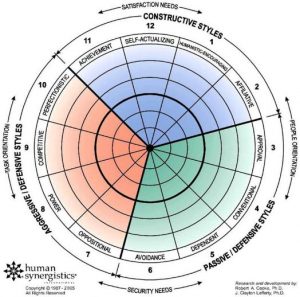
- Constructive – how you interact with others and approach tasks in ways that help them meet their higher-order satisfaction needs.
- Passive – how you interact with people, and whether you do this in a way that will threaten their own security.
- Aggressive – how you approach tasks, and if this is in a forceful way to protect your own status and security.
From an individual perspective, there are a number of different HS tools we use:
- Life Styles Inventory (LSI) 1 – is a self-assessment which measures the thoughts and attitudes that motivate your behaviour.
- Life Styles Inventory (LSI) 2 – is an assessment completed by others that provides feedback on how your behaviour patterns are interpreted by others, how you relate to others and how you solve problems and make decisions.
- Leadership/Impact (LI) – provides managers and executives with unique insights into their personal leadership strategies and the impact of those strategies on others’ behaviour and performance.
For groups and teams, we use the Group Styles Inventory (GSI), which is the only research-based tool of its kind that provides a proven, valid and reliable measure of how people in groups interact with each other and work as a team.
If you are looking for a solution for your organisation, the Organisational Culture Inventory (OCI) is the world’s most widely used tool for measuring organisational culture.
It is important to note that some people find these assessments confronting, but they have the potential to transform an individual’s effectiveness and fulfilment.
I would recommend these tools are used within Leadership Development Programs at all levels from CEO to emerging leaders, and also if you are looking to drive constructive changes in organisational and project culture.
Myers-Briggs Type Indicator (MBTI)
MBTI is a commonly used psychometric tool that focuses on individual preferences and personality types and looks at the variation in behaviour in ways individuals use their perception and judgement.
This is a great tool for multiple reasons:
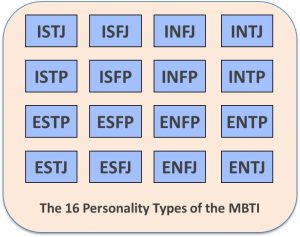
- Team development – teams can learn so much about the working and thinking styles of their colleagues and their team type
- Job design – enables you to design tasks and work around an individual’s strengths and personal preferences
- Leadership development – assists leaders to learn more about themselves and how they can get the most out of the people they lead
What I like the most about this tool is that it’s language is simple, and even without having someone do an assessment you can usually work out what profile they have and you can adjust the way you work and interact with them accordingly. One of the greatest learnings I had from this tool when we did a BRS team session on this at the start of the year was that we needed to ensure we are catering for all profiles in everything we do. For example, when you write a proposal for a potential client; usually they are not just read by one decision maker, and it is extremely unlikely that all of the decision makers would have the same profile. So when we write our proposals we need to ensure we cater for each of the profile type preferences.
This is a really cost effective tool to implement within teams and a great way for individuals within those teams to get to know each other, build relationships and work more effectively together.
Kolbe
I have only been introduced to Kolbe over recent months and I have to say I found this workshop one of the most enjoyable! Initially, when I first did my Kolbe A assessment I was a little sceptical, as the questions are a little out there and even more random than what I have seen in other assessments, but it was really interesting to see both mine and our team’s results.
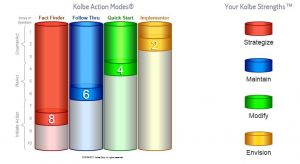
The Kolbe assessments identify the natural way that people take action. If left to our own choice, each of us has an instinctive way of problem solving and research shows that people are most productive when they are free to choose their own method of accomplishing a task or providing a solution about the conative part of the brain.
The main reasons you would use Kolbe’s assessments is to:
- Hire and keep the right people;
- Maximise employee potential; and
- Build successful project teams.
Initially, the reason we implemented Kolbe into BRS is to assist us with our recruitment. The Kolbe C Index allows you to create a profile for the role you are going to recruit for and you have your shortlisted candidates complete a Kolbe A Index that then determines their suitability for the role. We have gone through this process with our three newest team members, but as two of them are yet to commence it is a little premature to comment on our success (I’ll save this for another blog!).
However, during our one-day workshop, we found that this tool combined with the team chart and coaching tools were much more powerful to be used only for recruitment. Seeing each individual’s Mode of Operation (MO) has allowed us to adjust roles and allocation of projects and tasks to individuals who have MOs that align with this and I am really looking forward to how we continue to utilise Kolbe within our team.
Clifton StrengthsFinder (Gallup)
This is a cost effective tool developed by Gallup based on research by Donald Clifton. It measures an individual’s talents to identify and maximise their strengths and from this assessment, a total of 34 strengths are listed in order of dominance – the focus being on a person’s top five strengths.
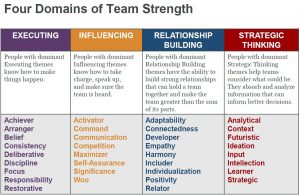
StrengthFinder is also very useful for team development as team leaders can align their team members’ roles with their strengths by referring to the Four Domains of Team Strength Table when completing the Team Strengths Grid for their team. The result is a high performing and well-rounded team, whose team members actively apply their talents and strengths every day!
StrengthFinder is most suited for:
- Team development – where teams can learn more about the working and thinking styles of their colleagues;
- Job design – by designing work around an individual’s strengths and personal preferences;
- Leader development – in assisting leaders to learn more about themselves and how they can get the most out of those they lead.
DISC
DISC is a personality measure assessing an individual’s natural behavioural styles and preferences as well as how these change in specific situations, including within a work team, a sales relationship, a leadership position or other relationships.
DISC profiles help you and your team:
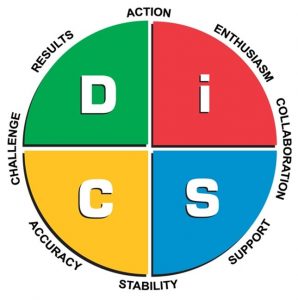
- Increase your self-knowledge: how you respond to conflict, what motivates you, what causes you stress and how you solve problems;
- Improve working relationships by recognising the communication needs of team members;
- Facilitate better teamwork and minimise team conflict;
- Develop stronger sales skills by identifying and responding to customer styles;
- Manage more effectively by understanding the dispositions and priorities of employees and team members;
- Become more self-knowledgeable, well-rounded and effective leaders;
DISC stands for:
- Dominance – Person places emphasis on accomplishing results, the bottom line and confidence;
- Influence – Person places emphasis on influencing or persuading others, openness and relationships;
- Steadiness – Person places emphasis on cooperation, sincerity and dependability; and
- Conscientiousness – Person places emphasis on quality and accuracy, expertise and competency
The greatest advantage of this tool is that it has a diverse range of uses, but it is most widely used within team building, recruitment, personal development and change management.
BRS Team Health Diagnostics
At BRS we have also developed our own Team Health Diagnostics that our clients use to assess the engagement of their bid, project, organisation and leadership teams at a particular point in time. We then run the same diagnostics each quarter for the duration of a year, or throughout the life of the project.
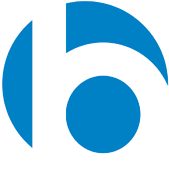
The greatest advantage of these diagnostics is that they can be tailored for a particular client or project and they provide an evidence based, timely approach to building high performance. The surveys are quick, cost effective and can be implemented for the Board/Governance bodies, management, bid or project teams, clients and stakeholder groups.
If you would like to learn more about BRS Team Health Diagnostics, please go to https://www.brsresults.com/capabilities/leadership-team-culture/team-health-diagnostics/
As you can see, diagnostic and psychometric tools are a useful way to assess behaviour accurately and reliably. However, different tools suit different purposes and have different strengths that are worth considering when selecting a tool for your needs – so make sure you consider the outcomes you are trying to achieve when selecting what tool is most suited to your situation.
All of the tools I have discussed are used extensively and the research behind each of them is very comprehensive, but I hope you’ve found my introduction useful.
Just a reminder, we have many coaches accredited in each of these tools who have extensive experience with working with individuals, leadership teams and project teams. If you would like to have a discussion with one of our team members about what tool would be most valuable to you or your team, please contact us at enquiries@brsresults.com



